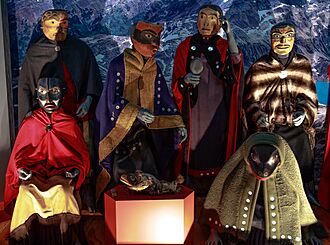Nisg̱aʼa Museum facts for kids
Quick facts for kids Nisg̱aʼa Museum |
|
|---|---|
|
Hli G̱oothl Wilp-Adoḵshl Nisg̱aʼa
|
|
 |
|
| General information | |
| Location | 810 Highway Drive, Lax̱g̱altsʼap, British Columbia, Canada |
| Coordinates | 55°01′58″N 129°34′53″W / 55.0327°N 129.5814°W |
| Completed | 2011 |
| Cost | $14 million |
| Technical details | |
| Floor area | 10,000 sq ft (930 m2) |
| Design and construction | |
| Architect | Hillel Architecture |
The Nisg̱aʼa Museum is a special place that celebrates the history and culture of the Nisg̱aʼa people. It is located in Lax̱g̱altsʼap, a village in northwestern British Columbia, Canada. The Nisg̱aʼa name for the museum, Hli G̱oothl Wilp-Adoḵshl Nisg̱aʼa, means "the heart of Nisg̱aʼa House crests." This name shows how important tribal crests are to the Nisg̱aʼa community.
The museum was created by the Nisg̱aʼa Lisims Government. It opened in the spring of 2011. It is a place where Nisg̱aʼa artifacts are shown, traditions are shared, and people can learn and do research. The museum has one of the best collections of art from the Northwest Coast Indigenous peoples. The museum's website says it is "our gift to each other, our fellow Canadians and the world."
Contents
What Can You See at the Museum?
In the late 1800s and early 1900s, many Nisg̱aʼa treasures were taken from the Nass Valley. This happened when missionaries settled along the Nass River. The museum's main collection is called the Ancestors' Collection (Anhooyaʼahl Gaʼangigatgumʼ). It has over 330 artifacts that were returned to the Nisg̱aʼa people. These items came from places like the Royal British Columbia Museum and the Canadian Museum of Civilization. They were returned because of the Nisg̱aʼa Treaty.
You enter the exhibits through a copy of a traditional Nisg̱aʼa longhouse. The museum has four main galleries:
Transformation Gallery: Masks and Spirits
This gallery shows many naxnok, or spirit masks. It celebrates the Nisg̱aʼa performers who brought these spirits to life.
Halayt Gallery: Shamanic Tools
Here, you can see items used by Nisg̱aʼa shamans. These tools helped them connect with and guide supernatural forces.
Ayuuk Gallery: Chiefs' Treasures
This section displays a chief's box, called a hoohlgan. It holds special clothing and items that show the social roles and rules of the Nisg̱aʼa people. These rules are part of the Nisg̱aʼa laws and customs, known as Ayuukhl Nisg̱aʼa.
Living River Gallery: Daily Life Items
This gallery shows items used in everyday life in a traditional Nisg̱aʼa longhouse. You can also see tools used on the land or along the banks of the Nass River, which is called Lisims.
Most of the artifacts are displayed openly, so you can see them up close. Only the most delicate or valuable items are behind glass. The museum has motion sensors to keep everything safe. There are also four house poles, or totem poles, carved especially for the museum. Each pole represents one of the four Nisg̱aʼa clans.
The museum plans to add more exhibits in the future. These will cover the natural history and recent history of the Nisg̱aʼa people. They will also show the journey to get their traditional lands back and how they became a self-governing nation.
The Ni'isjoohl Totem Pole
The Ni'isjoohl totem pole is a large, hand-carved totem pole, about 31 feet (9.4 meters) tall. The House of Ni’isjoohl ordered this pole in the 1800s to honor Ts'wawit. He was a Nisg̱aʼa warrior who died in battle. In 1929, the pole was taken without permission and sent to the Royal Scottish Museum. On September 29, 2023, the pole officially returned to the Nisg̱aʼa people. It is now proudly displayed in the Nisg̱aʼa Museum.
About the Museum Building
Planning for the Nisg̱aʼa Museum started in the 1990s. Money for the museum was part of the Nisg̱aʼa Treaty settlement. In September 2010, a special ceremony welcomed the artifacts back to the Nisg̱aʼa. The Royal Canadian Mounted Police even helped bring them safely. The museum building cost $14 million and opened on May 11, 2011. This date was also the 11th anniversary of the Nisg̱aʼa Treaty being signed.
The building's design looks like traditional Nisg̱aʼa forms. The floor plan is shaped like a feast bowl. The cross-section of the building looks like a traditional longhouse. The roof is shaped like a canoe. The canoe shape and its location on a gravel area, like a beach, remind people of the motto for the Nisg̱aʼa Treaty signing: "our canoe has landed."
The museum has a special climate-controlled gallery space. This means the temperature and humidity are carefully controlled to protect the artifacts. It is the only one of its kind in British Columbia's northwest. The museum also has very modern security systems.
External Links
- Nisgaa Museum
- Nisga'a Museum – Nisga'a Lisims Government
- Nisga'a Nation Knowledge Network
- Photo gallery on the exhibit designer's webpage

